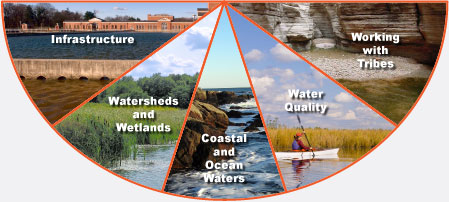Water: Climate Change and Water
Climate Change and Water
Principles for an Energy-Water Future
Climate Resilience Evaluation & Awareness Tool (CREAT)
Climate Ready Estuaries Vulnerability Assessments - A Novel Approach
EPA's Planning for Sustainability: A Handbook for Water and Wastewater Utilities
Climate change is changing our assumptions about water resources. As climate change warms the atmosphere and alters the hydrological cycle, we will continue to witness changes to the amount, timing, form, and intensity of precipitation and the flow of water in watersheds, as well as the quality of aquatic and marine environments. These changes are also likely to affect the programs designed to protect the quality of water resources and public health and safety.
EPA is working with state, tribal, and local governments and public and private stakeholders to understand the science, develop tools, and implement actions to respond to the impacts of climate change on water resources and to reduce emissions of greenhouse gases.
The "2012 Response to Climate Change" strategy presents five long-term visions designed to shape EPA's future work on climate change and water issues based on the growing understanding of climate change. Each of these vision areas identifies a range of long-term goals and the strategic actions that need to be taken in the coming years to achieve those goals.

EPA is working to respond to climate change not only on a national scale, but also at the local and regional levels. EPA's regional programs provide a platform for integrating actions across media, including air, water, and land.

The first "National Water Program Strategy: Response to Climate Change" was published in 2008 and describes the key near-term actions that must be taken to begin to understand and respond to the potential impacts of climate change on water resources and EPA's mission. The 2012 strategy builds on the momentum gained since then and describes, in light of climate change, a set of long-term visions and goals for the management of sustainable water resources for future generations. The 2012 strategy charts the strategic actions that need to be taken to achieve those goals.
- 2012 National Water Program Strategy
- 2008 National Water Program Strategy and Progress Reports
- Federal Collaborations on Climate Change and Water

Looking for more information? View a more complete listing of available resources to help you take action to reduce greenhouse gas emissions and build resilience to the impacts of climate change.
- Resources and Tools
- Partners and Stakeholders
- Calendar of Events
- Climate Change and Water E-Newsletter

Key EPA Programs and Initiatives
Climate Ready Estuaries | Climate Ready Water Utilities | Green Infrastructure | Healthy Watersheds | Sustainable Infrastructure | WaterSense
 Stay Informed
Stay Informed
- Subscribe to the climate change and water e-newsletter.
- See our calendar of climate change and water related events.
- Have a comment? Ask a question.
E-mail us at: water_climate_change@epa.gov.
How Does Climate Change Affect Water Resources?
While impacts will vary in different regions of the U.S., potential impacts include increased flooding and drought, water quality and ecological impairment, damage to infrastructure, and other impacts to society caused by:
- Severity and length of droughts.
- Less total annual rainfall, less snowpack in the mountains and earlier snowmelt.
- Warming air temperature that raises stream and lake temperatures.
- Increases in rain and heavy precipitation events.
- Sea level rise and encroachment of saline waters into freshwater areas.


